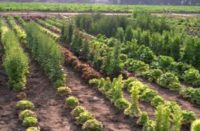Lettuce
 Lettuce has two peculiarities: it needs light for optimum germination and it will not germinate in hot soil. Lettuce is easy to grow as long as proper timing of planting in the fall and early spring is followed. It is fast growing and can be planted among other slower growing plants. All lettuce can be direct-seeded, but if you want to avoid the thinning or want to space plants on a raised bed or for a drip system, any of the varieties can be seeded in containers and transplanted into the garden beds at the fourth week. Temperature controls rate of growth. The best range for lettuce development is between 60 and 75 degrees F. Bolting(flowering) in lettuce is induced by high temperatures, generally several days above 80 degrees. However, fluctuating temperatures in the fall and winter can stimulate reproductive growth or retard it. A fall planting (of transplants) in late September or early October can be harvested in four weeks, if every day is the right temperature for growing one. If the growth of a young plant is checked (retarded) by lack of nutrients or water, it never fully recovers. In my garden, I not only apply slow release complete fertilizer before planting, and also feed young plants weekly with a dilution of fish and seaweed emulsion. Plant lettuce seed ¼ inch deep or place 2 or 3 seeds in each cell of a multi-celled tray and lightly sift compost to cover. Water with a fine mister. Daily watering is necessary in early fall. After plants are up, water on a regular basis. Early fall plantings of lettuce can be damaged by cabbage worms and cutworms. A caterpillar control called Bt can control the problem if discovered soon enough. The material is used as a "preventative" and must be reapplied every 5 -7 days. Fungus diseases, such as rots and mildew can cause problems in wet weather. Resistant or tolerant varieties have been developed for California Crisphead types. Birds can also be a problem in the fall when most succulent growth will attract them. Nylon netting or floating row-covers on hoops will keep them off.
Lettuce has two peculiarities: it needs light for optimum germination and it will not germinate in hot soil. Lettuce is easy to grow as long as proper timing of planting in the fall and early spring is followed. It is fast growing and can be planted among other slower growing plants. All lettuce can be direct-seeded, but if you want to avoid the thinning or want to space plants on a raised bed or for a drip system, any of the varieties can be seeded in containers and transplanted into the garden beds at the fourth week. Temperature controls rate of growth. The best range for lettuce development is between 60 and 75 degrees F. Bolting(flowering) in lettuce is induced by high temperatures, generally several days above 80 degrees. However, fluctuating temperatures in the fall and winter can stimulate reproductive growth or retard it. A fall planting (of transplants) in late September or early October can be harvested in four weeks, if every day is the right temperature for growing one. If the growth of a young plant is checked (retarded) by lack of nutrients or water, it never fully recovers. In my garden, I not only apply slow release complete fertilizer before planting, and also feed young plants weekly with a dilution of fish and seaweed emulsion. Plant lettuce seed ¼ inch deep or place 2 or 3 seeds in each cell of a multi-celled tray and lightly sift compost to cover. Water with a fine mister. Daily watering is necessary in early fall. After plants are up, water on a regular basis. Early fall plantings of lettuce can be damaged by cabbage worms and cutworms. A caterpillar control called Bt can control the problem if discovered soon enough. The material is used as a "preventative" and must be reapplied every 5 -7 days. Fungus diseases, such as rots and mildew can cause problems in wet weather. Resistant or tolerant varieties have been developed for California Crisphead types. Birds can also be a problem in the fall when most succulent growth will attract them. Nylon netting or floating row-covers on hoops will keep them off.
Also check out ...
http://vric.ucdavis.edu/veg_info_crop/lettuce.htm
http://www.ipm.ucdavis.edu/PMG/selectnewpest.lettuce.html
Varieties
There are four classes of lettuce: LOOSELEAF, like Black Seeded Simpson and Red Sails; CRISPHEAD, like Iceberg and Great Lakes; BUTTERHEAD, like Bibb and Buttercrunch; and ROMAINE or COS, like Rouge d'Hiver or Winter Density.

